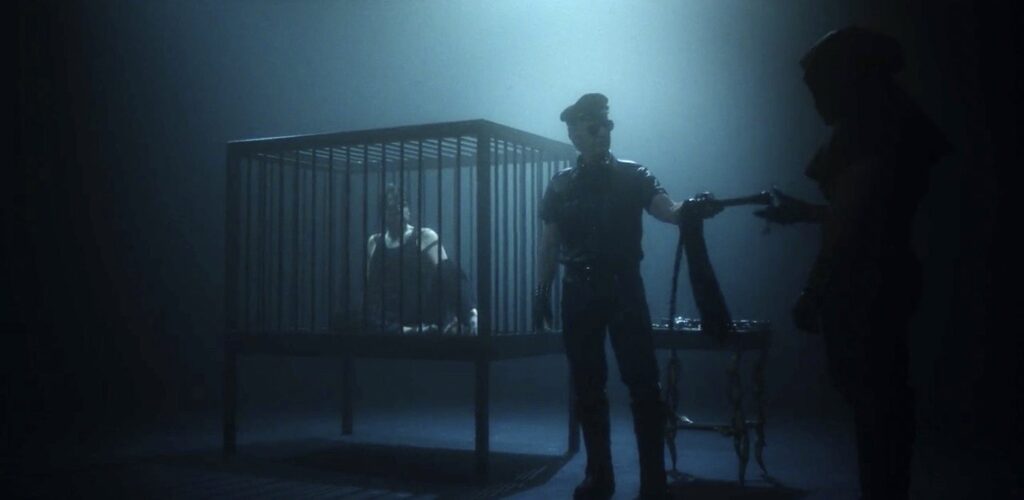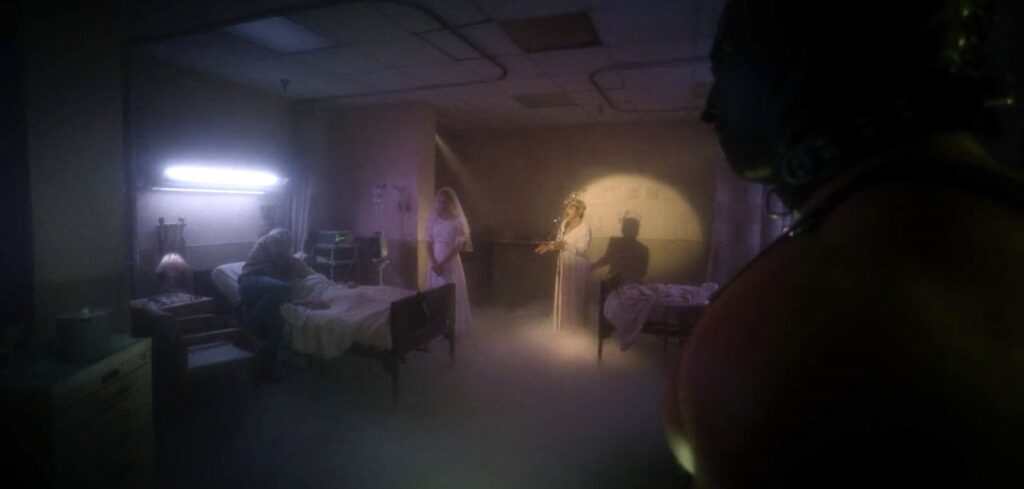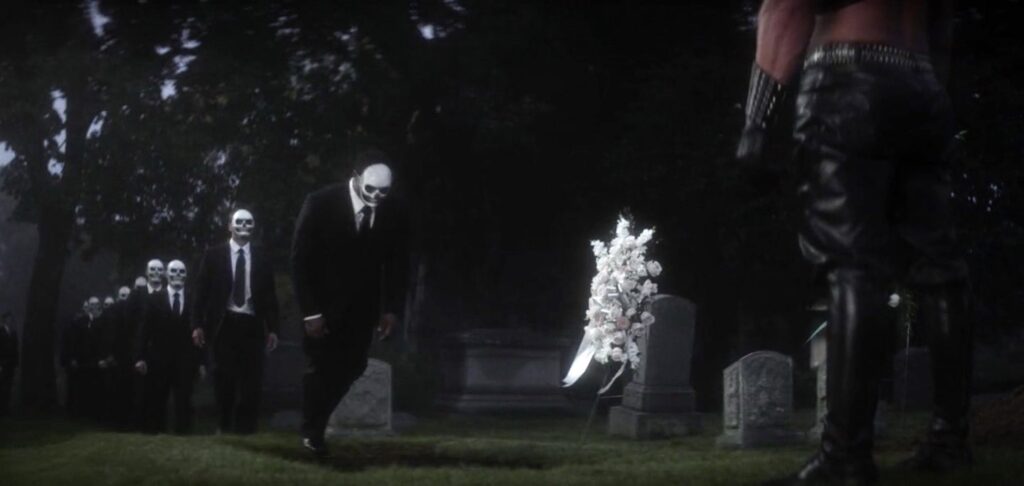Want to hear more from the actors and creators of your favorite shows and films? Subscribe to The Cinema Spot on YouTube for all of our upcoming interviews!
Lead Critic for the site, as well as serving as an editor when needed.
American Horror Story: NYC finishes a decent last half of the season with a lackluster finale that ultimately could have been better. While the penultimate episode begins where the eighth episode left off, both of these final episodes act as a reflection piece more than anything, in the most useless ways.
The cast remains the key standout of the season, while the writing didn’t pay off in the end, however, some aspects of the writing shined through better than what didn’t. I believe the core message Ryan Murphy and Brad Falchuk wanted to get across was ever-present, especially in “Part Two,” but it seems the writing team lagged behind a bit in the end with the execution.
Spoilers to follow.
Episode Nine Discussion
First of all, by the end of the finale, it felt as if the writing would have been much better with three parts to this finale, thus giving an eleven-episode count to Season Eleven. It also would have made more sense, and the last frame of the season is even puzzling, which is quite annoying.
“Part One” seems to begin with Theo Graves’s (Isaac Powell) funeral, but alas, it is but a dream sequence in the mind of Sam (Zachary Quinto), as he is now dying from acquired immunodeficiency syndrome, or AIDS, the disease caused by human immunodeficiency virus (HIV); the mysterious disease that Dr. Hannah Wells (Billie Lourd) was studying all season before she too succumbed to it. The penultimate episode is written and directed by Our Lady J.

Character Developments
Most of this episode takes place within Sam and Patrick Read’s (Russell Tovey) minds, as they both die due to the illness. I will say, it is nice to see Sam finally confront the trauma he has deep inside himself. This is one of Quinto’s more wild characters on the show, and even perhaps, the most fleshed-out one as well. He was a complete douche for ninety percent of his screen time this season and hurt a lot of men. In “Part One” he is finally forced to confront the source and causes of his hurt on others in order to truly forgive himself and be at peace as he dies. This development could have come a bit sooner but Sam’s use in the plot made more sense for it to come right at this very moment when he is at his most vulnerable, facing death.
Henry (Denis O’Hare) is also the character who forces Sam to accept most of what he has done, and this is also one of the more complex characters that O’Hare has played on the show. While Henry even points out that he and Sam aren’t too different, Henry only does the “grotesque” when necessary, unlike Sam. Henry is a mob hitman, after all. Sam reflects on his pain in the men he has sex with and uses BDSM to “take it away,” but he’s actually in pain.
Similar to Henry, being a mob hitman, he uses his pain for some purpose by channeling it through mob-sanctioned actions. They both need to accept their pain, forgive the cause and try to accept who they really are, to be at peace.
Big Daddy (Matthew William Bishop) also continues his reign of terror, but as I figured, is just another odd supernatural character that serves some form of an external purpose for the main characters of the season. Big Daddy isn’t “real” per se, but he is present throughout the season and interacts with everyone else, but they’re only that, just there. He could be some form of an Angel of Death as well, especially for our characters. He terrorizes Sam in his dream sequence and is present through most of Gino Barelli’s (Joe Mantello) grieving process of the season’s events in the finale.

Elements of the Episode
It seems the core theme of “Part One” was the meaning of accepting your grief, and who people can really be deep down inside. J also wanted to make the characters reflect on their defining moments in life, or those who defined what they ended up as, and their decisions in life. Both episodes did a fantastic job at projecting the loneliness and dread that came with having HIV/AIDS in the 80s and the unaccepting trauma that patients had to suffer through during their final days. However, for me, it is a bit of a cop-out that several of the season’s characters died due to AIDS.
“Part One’s” direction is pretty subpar compared to the rest of the season. The early episodes had some of the season’s best shots. However, J does a great job at keeping the characters who are dying in the center of the frame and really wants to project everything onto the viewer through the frame with their grief. Their grief takes center stage during these key shots. The color grading, by Tanner Buschman, feels older than most of the season as well, which is probably on purpose being that most of these two episodes are within dream sequences. The lighting work, by Eric Boncher, is fantastic in “Part One,” and really makes you feel the grief and silence setting in during key moments with our characters as they begin to pass.
Spoilers for the finale to follow.
Episode Ten Discussion
“Part Two” updates the audience on Dr. Wells’ (Lourd) fate and shifts focus to other characters from NYC, mainly Adam Carpenter (Charlie Carver) and Gino (Mantello). The titles of these episodes, “Requiem 1981/1987 Part One” & “Two,” should have been something a little more simple, as, by the end of the finale, the story is in 1991. It gives more weight to this finale being jumbled and almost careless, as this was one of the most unsatisfying season finales of the show’s entire run since 2011. It seems the creatives had everything right until they reached a point where they didn’t really have a clear-cut idea about how to end the season. So, what the hell, let’s just kill most of our characters and make them all reflect on everything they’ve ever done, ’cause that always works right? The finale episode is written by Ned Martel & Charlie Carver, while Jennifer Lynch returns to the director’s chair.
This element is, perhaps, my favorite of the whole season, and it’s been present the whole time for those paying close attention: the continuity of the characters and the events as they happen. This episode begins with the discovery of Hannah’s body, which has apparently been decomposing for some time. This meant that in Episode Seven when Hannah decided to go to her mom’s instead of going with the gang to Fire Island, she never hung up the phone and never even made it to her mom’s.
She died in her apartment after she called Adam to give him a raincheck and she called her mom; Adam goes to her apartment after Theo’s funeral and asks the detective what could have happened and there is a shot of Hannah’s telephone on the ground, rather than resting on the set. Thus, the events from Episode Eight onwards, happened to our characters as Hannah lay dead in her apartment, while everyone assumed she was okay at her mom’s. This small element is fantastic and deserves significant praise. It left me the most satisfied in an otherwise chaotic finale.

Grief and Reflection in American Horror Story: NYC
Similar to “Part One,” “Part Two’s” core theme is reflection. It also wants the characters to reflect on their current position in life. But “Part Two” also serves as a reminder that grief is real, and everyone experiences it in their way. Unfortunately, Patrick’s mom and brother turn Gino away at Patrick’s funeral and that was their way of grieving. It’s mostly wrong and twisted, they didn’t accept Patrick for who he was, but Gino loved him more than anything and was just glad he could see his lover (as Gino says several times throughout) put to rest.
However, in that grief, we must also not forget how to live. Adam seems to be turning into some sort of safe sex advocate, hanging up posters advertising condom use among gay men, but also mustn’t forget how to live. He must carry on and live life to its fullest, whatever that means to him. The same can be said for our audience, while in the midst of tragedy, grieve and reflect for sure, but certainly don’t get stuck and forget how to live. Adam began to advocate for safer sex practices in the gay community, and Gino continued to write for The Native about issues gay men faced and reflected on his trauma as he also eventually succumbs to AIDS in 1991.
Lynch’s direction gave us some of the better shots throughout the season. Her dolly work is creative and helps the characters during movement in some scenes. The cinematography, as a whole, has been an improvement compared to recent seasons of the show, and the editing has been some of the best in the entire run of the show. The lighting work in the finale seemed sloppier than in the penultimate episode, but it worked nonetheless. Carver also wrote four episodes of the season, which are some of the best. However, “Part Two,” isn’t as put together as “Part One” and by the end, you are left wanting more.
Final Thoughts on American Horror Story: NYC
When compared to the best seasons of the show, One through Four (Murder House, Asylum, Coven & Freak Show), Season 11 can stand with them, as most of NYC had the same form as those seasons. It is better than the middle seasons, Five through Eight, but not quite as enticing for me as Season Nine, 1984, and Season Ten, Double Feature, is a bit better too. The cast was one of the best parts of NYC, and all of the small elements kept me on the train. However, it does seem that they kind of overwhelmed themselves this season and didn’t keep the train on the right set of tracks. Everything was pretty good, and then these last two episodes just didn’t fill the void quite well.
The core themes and messages were present as the season progressed rather than appearing halfway through the season and never appearing. The mysterious element made a stronger return this season than in some of the recent seasons where it either failed or wasn’t present at all, which is what made American Horror Story so popular, to begin with. Mantello, O’Hare, and Carver are the top performers among the cast. Perhaps with more screen time, Grossman could’ve made a better return than anyone else, seeing that she played a more tragic character this season than in past ones.
As also mentioned, this was a lackluster finale for the tone they choose to set early on. The mass chaos continued but wasn’t as contained as it definitely should’ve been by the end. “Fire Island” is the best episode this season and is the most put together among these last half of episodes. The idea to make these last two episodes nothing more than reflection pieces is a wasted opportunity and feels lazier than anything else. However, the writing is among the better parts of the episodes regardless of anything else.
American Horror Story has been renewed up until at least season thirteen, leaving hope for two more creative seasons of horror television. My biggest want for Season Twelve, as is probably many fans, is the return of old cast members like Evan Peters and Sarah Paulson. I’d also like to see Finn Wittrock return to the show, as his character last season was his best and I’d like to see him top it. Seeing Dylan McDermott return would also be cool. Seeing what Murphy & Falchuk will churn out two more times will be interesting nonetheless.
What are your thoughts on these final two episodes, and NYC as a whole? Covering this season was a blast, and for more horror-related pieces, especially as we ramp up for coverage of Chucky Season Two, stay with us here at The Cinema Spot!
Lead Critic for the site, as well as serving as an editor when needed.
This article was edited by John Tangalin.
